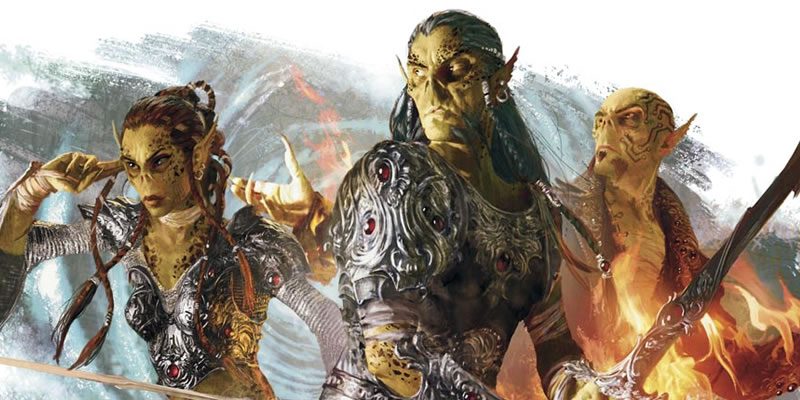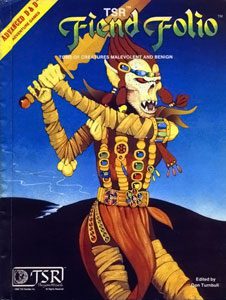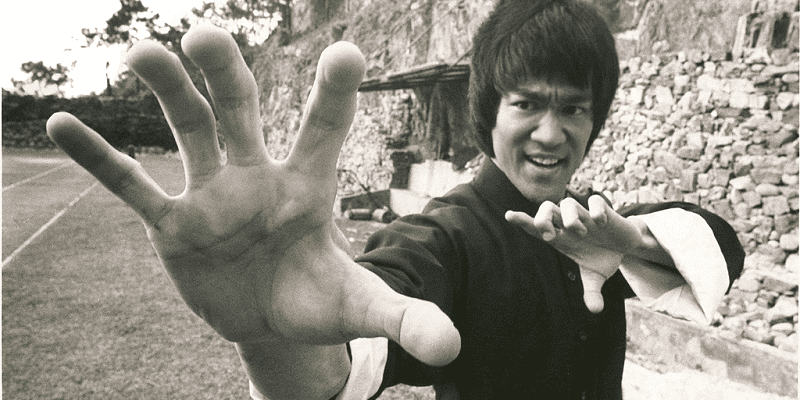Gith Player Characters for 5th edition

The githyanki and githzerai (sometimes referred to collectively as the “gith”) were created by Charles Stross for his own AD&D game and first appeared in the April/May 1979 issue of White Dwarf magazine. They gained their prominence in the D&D pantheon for their fascinating origin and unique powers, as well as gracing the cover of the 1981 Fiend Folio.
Though the history of the gith races and their link to the illithids (mind flayers) are described in the 5th ed Monster Manual, no article would be complete without mentioning the now-classic “Incursion”, a detailed campaign concept running through July 2003’s Dragon #309 and Dungeon #100. These two issues focused almost exclusively on the githyanki, granting detailed insight into their culture, new templates, alternate classes, prestige classes, campaign ideas, and even a mini-game where you play evil githyanki in the service of their queen. Dungeon #100 included the duthka’gith, the kr’y’izoth, the tl’a’ikith, and Vlaakith the Lich-Queen.
illithids (mind flayers) are described in the 5th ed Monster Manual, no article would be complete without mentioning the now-classic “Incursion”, a detailed campaign concept running through July 2003’s Dragon #309 and Dungeon #100. These two issues focused almost exclusively on the githyanki, granting detailed insight into their culture, new templates, alternate classes, prestige classes, campaign ideas, and even a mini-game where you play evil githyanki in the service of their queen. Dungeon #100 included the duthka’gith, the kr’y’izoth, the tl’a’ikith, and Vlaakith the Lich-Queen.
Arguably the most famous githzerai is Dak’kon from the game Planescape: Torment. A fascinating character that did for gith PCs what Drizzt did for drow (though admittedly on a far smaller scale). Dak’kon gave players an insight into the life and psyche of a githzerai character. [Huge thanks to Adam Mulford for pointing out the glaring error of Dak’kon not being mentioned. Apologies also to Dak’kon.]
- You can find more backgrounds and class archetypes ideal for gith PCs in our follow-up article.
- You can also find a useful list of gith phrases over at the Planeswalker Project.
- For more about the history of the gith, check out this awesome article from Power Score.
- For a fascinating game-play video of a githyanki adventure, check this out.
Alignment and the Gith
Gith, especially githyanki, are excellent examples of how the alignment system should work in D&D. Githyanki are a matriarchal meritocracy, meaning they are led by a queen and gain prestige and social standing through their achievements. Their militaristic social structure would lead many players to assume they are all lawful in alignment, but the race’s history of slavery to the mind flayers means that chaotic and neutrally aligned githyanki are as common as those who believe order in all aspects of life is the way the world should run.
Does that mean that a chaotic or neutral githyanki will ignore direct orders or secretly fight against their undead queen? Not at all. Most githyanki understand, accept, and even embrace the meritocracy, and martial law that rules their society, along with being respected for their fight for individual freedoms.
The alignment system, particularly in 5th edition, is meant to be a guideline outlining a PC’s ideal belief of how the world should work, but is not meant to be a checklist of ideals to be imposed on others. A lawful character believes that in an ideal world, order allows civilized peoples to achieve their best. It does not mean that they obey every law without question, or force others to. It can certainly be that way for certain personalities, but it is not an absolute. Chaotic characters believe that personal freedom is the way to a better world (whether or not the “better world” is for everyone, or for the PC/their race/their culture refers more to their good/evil track). Does that mean that chaotic characters never have a code of behavior, or will never follow the orders of a leader they respect? Not at all, though they are far more likely to question their superiors. The Merry Men of Sherwood follow Robin Hood because they believe in his leadership, even though they are arguably chaotic good.
This dichotomy is best described by James Wyatt, in Dungeon#100/Polyhedron #159:
“The githyanki are uniformly evil, but individuals are as often lawful as chaotic evil. Their society is probably best described as neutral evil, with a militaristic regimentation balanced by a strong ethic of individual freedom and personal achievement, focused above all toward ends of hatred and death.
“As a result of their racial origin as slaves of the mind flayers, githyanki place an extremely high value on freedom. More lawfully-inclinded githyanki emphasize the freedom of the githyanki as a race, swearing that the race shall never again be subjugated to other powers while also stressing the need for individual githyanki to forfeit at least some of their own personal freedom for the greater benefit of the race. Githyanki who lean more toward chaos argue that personal enslavement to the githyanki race as a whole is little better than servitude to the mind flayers, and stress every individual githyanki’s right to live free of oppressive regulation. Most githyanki live content in the middle ground between the two extremes, finding their own balance between subservience to their race and personal freedom.”
Githzerai exhibit these same tendencies, but for very different reasons. Githzerai live in the turmoil of Limbo, surviving only by imposing their will on the malleable reality of their home. No matter how lawful a githzerai may be, the race as a whole is exposed to a level of chaos that is hard for Material Plane beings to comprehend. The “order” in a githzerai’s mind is often an exercise in riding the chaos, removing their own expectations of reality, and developing an awareness of exactly when and where they can influence Limbo instead of forcing the plane to bend to their will.
The githzerai’s perceived calmness is relative. A githzerai on the Material Plane sees the wars, death, and survival challenges as minor ebbs and flows compared to its residents. Their serenity may be born as much from embracing the chaos as from an orderly and focused (ie: lawful) mind.
Githyanki Traits
Ability Score Increase. Your Strength score increases by 2, and your Wisdom score increases by 1.
Age. It is nearly impossible to determine the true age of a githyanki, as creatures who live on the Astral Plane do not age. Hatcheries and young githyanki are born and raised in highly secretive creches across the Material Plane and reach maturity at 16 years of age. Scholars believe that if allowed to age on the Material Plane githyanki could live as long as a century.
Alignment. See Alignment and the Gith above.
Size. Though slighter of build and taller than humans, githyanki possess highly efficient and finely toned musculature, granting them impressive and often surprising strength. Your size is Medium.
Speed. Your walking speed is 30 feet.
Innate Psionics. You gain the mage hand cantrip. The hand summoned by this spell is invisible. At 1st level you may cast jump once per long rest. At 3rd level, you may cast misty step once per long rest. At 5th level, you may cast tongues once per long rest with a range of Personal. These spells are considered psionic powers, therefore you may cast them without the use of material components. Wisdom is your spellcasting ability with these spells.
Bred for War. You gain proficiency with either Athletics or Intimidate checks (your choice).
Languages. You speak, read and write Gith as well as one other language (typically Common).
Githyanki Classes
Githyanki are all followers of Vlaakith, the Lich Queen, and as such do not follow any divine powers. NPC githyanki are never clerics, druids, or paladins, or any variant class that uses divine magic. Fighters and rangers are quite common, with bards, eldritch knights, and arcane tricksters only slightly less common. The majority of githyanki units possess at least one gish or pyromancer (evokers who specialize in fire).
Gish
Any githyanki possessing a class that combines melee combat with arcane spellcasting is called a gish. Gish are given the same level of respect no matter what “sub-specialty” they possess and distinction between them by the general populace is irrelevant.
Blackguard
Though not technically a god, Vlaakith, does grant significant power to a select few of her most promising warriors. Blackguard have the same abilities as the Oath of Vengeance paladin with the exception that their Divine Smite class feature deals necrotic damage instead of radiant. They do manipulate the essence of the Astral plane to exhibit limited healing powers, though those who wish may replace their Lay on Hands ability with the following when taking the class at 1st level:
Touch of Death
The blackguard may draw life from creatures with a touch. As an action, make a spell attack to touch an opponent within your reach. On a successful attack, you deal 1d8 necrotic damage to the target. You heal an amount of damage equal to 1/2 the damage dealt. This damage increases to 2d8 at 5th level, 3d8 at 11th level, and 4d8 at 17th level. You may use this ability a number of times per day equal to your Charisma modifier.
Tenets of the Lich Queen
My Soul for My Queen. There is no being greater than my queen. Those who think otherwise will either serve her, or meet their false gods.
My Body for My People. I will not allow the enemies of my people to go unpunished. Though servitude may be just punishment for some, those who once enslaved my people will be granted no mercy.
My Mind for My Own. No other creature will again force my service or crush my will.
My Blood Runs with Silver. The blade given to me by my queen will never be far from side. I understand that should it be permanently lost, my power, if not my life, is forfeit.
Blackguard rarely level past 16th or 17th as Vlaakith is terrified of those with too much power.
Silver Greatsword
A Blackguard that reaches 5th level is commonly granted a silver greatsword. These swords are magical +1 greatswords that require attunement. They also possess the following special ability:
Sever Astral Chord: On a critical hit against a target with an astral body (such as granted by the astral projection spell), the wielder may choose to do no damage. If they do, they instead sever the silver chord that tethers the target to its material body.
Over time, the Blackguard binds psychically to their weapon. The silver greatsword gains the following abilities as the bearer gains levels:
11th level: The weapon becomes +2.
14th level: The weapon deals an additional 3d6 (10) psychic damage on a successful hit.
17th level: The weapon becomes +3.
Invasions of the Material Plane have been started over the stealing of one of these rare weapons. Should a silver greatsword be permanently lost, the Blackguard’s life is forfeit and their soul is used as fodder for the Lich Queen’s experiments. The resulting creatures become living (or undead) examples of failure.
The astral silver quality can also be applied to other weapons at the DM’s discretion. Though blackguards are often awarded a silver greatsword, weapons with this quality are not limited to them.
Githzerai Traits
Ability Score Increase. Your Dexterity score increases by 2, and your Wisdom score increases by 1.
Age. As with githyanki, it is difficult to tell a githzerai’s true age though the reasons are far different. Githzerai reside on the chaotic plane of Limbo, a plane that answers to the will of the sentient beings that reside there. Though creatures age in Limbo it is suspected that the strength of the githzerais’ will can allow it to survive decades, if not centuries, longer than it would living on the Material Plane. If born and raised on the Material Plane, scholars believe githzerai would reach maturity around the age of 16 and could live as long as 150 years.
Alignment. See Alignment and the Gith above.
Size. Though slighter of build and slightly taller than humans, githzerai possess equivalent muscle strength but lighter mass. This muscle-to-body-mass ratio grants them sometimes shocking agility and speed. Your size is Medium.
Speed. Your walking speed is 30 feet.
Innate Psionics. You gain the mage hand cantrip. The hand summoned by this spell is invisible. In addition, choose one of the following spells: feather fall, jump, or shield. You may cast the chosen spell once per long rest. At 3rd level, you may select a second spell from the list. At 5th level, you may cast see invisibility once per long rest. These spells are considered psionic powers, therefore you may cast them without the use of material components. Wisdom is your spellcasting ability with these spells.
Telempathic. You gain proficiency with either Insight or Perception checks (your choice)
Languages. You speak, read and write Gith as well as one other language (typically Common).
Githzerai Classes
Githzerai PCs are almost exclusively monks, though fighter, rogue, sorcerer, and wizards are not unknown. Githzerai monks most often follow the Way of Zerthimon tradition presented below. Some specialized monasteries train their students in one of the core three traditions from the Player’s Handbook.
As with githyanki, it is rare for githzerai to follow divine classes. They see the path to self-improvement as a philosophical struggle more than a theological one.
New Monastic Tradition
The Way of Zerthimon
The fighting style of the githzerai monks enhances their innate psionic powers and strength of will. To learn this path, you must possess the mage hand cantrip. [If you are of a non-gith race, you may gain the cantrip through levels in bard, rogue (arcane trickster), sorcerer, warlock, or wizard, through the High Elf’s bonus cantrip feature, through the Magic Adept feat, or some other path at your DM’s discretion.]
Mind’s Eye Techniques
Starting when you choose this tradition at 3rd level, you learn to focus your innate psionic powers in a variety of ways.
Force Strike
Whenever you take the Attack action, you may spend 1 Ki point to apply the Reach quality to your unarmed strikes until the end of your turn.
Telekinetic Defense
You may spend 2 Ki points to cast the shield spell as a reaction.
Invoking Limbo
At 6th level, you have learned to impose your will on planes other than Limbo. As an action, you may spend 2 Ki points to cast jump. As a reaction, you may spend 2 Ki points to cast feather fall. These spells are consider psionic and therefore do not require material components to cast.
Arena of the Mind
At 11th level, you have learned to take the combat into your opponent’s psyche, turning their image of you into their worst nightmare. As an action, you may spend 5 Ki points to cast phantasmal killer as a 4th level spell.
Walking the Worlds
At 17th level, as an action, you may spend 8 Ki points to cast plane shift. Use of this ability does not require material components.
Design Notes: Thanks to reddit follower 3Vyf7nm4 for pointing out a discrepancy in the point costs of Arena of the Mind and Walking the Worlds. The costs have been corrected.
Another option that was discussed is to remove the long-rest limit on Arena of the Mind, but also remove the ability to buff via more Ki points. That would parallel the Elemental tradition a little more closely by allowing the 11th level monk to use it twice per day, but at the power of a 4th level spell (normally castable by a 7th level caster). We will continue to playtest these options and would love additional feedback.
The long-rest limit on Walking the Worlds has also been removed.
Playtesting
We’re always looking for playtesters for our races, classes, archetypes and other designs here at Tribality. Wizards had the benefit of 175,000 playtesters over 2 years to get their ideas to the table; clearly we don’t have that luxury. Each of our builds are as balanced as we can design with a small playtest group and over a century of cumulative gaming XP. We are always excited to hear when players get these ideas on the table and provide us with constructive ways to make them better.
This illustration of githyanki by Michael Komarck accompanied the race's description in the 4th edition D&D Monster Manual.



